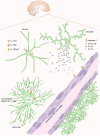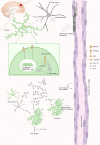Interleukin-1 Receptor Antagonist as Therapy for Traumatic Brain Injury
- PMID: 37610701
- PMCID: PMC10684479
- DOI: 10.1007/s13311-023-01421-0
Interleukin-1 Receptor Antagonist as Therapy for Traumatic Brain Injury
Abstract
Traumatic brain injury is a common type of acquired brain injury of varying severity carrying potentially deleterious consequences for the afflicted individuals, families, and society. Following the initial, traumatically induced insult, cellular injury processes ensue. These are believed to be amenable to treatment. Among such injuries, neuroinflammation has gained interest and has become a specific focus for both experimental and clinical researchers. Neuroinflammation is elicited almost immediately following trauma, and extend for a long time, possibly for years, after the primary injury. In the acute phase, the inflammatory response is characterized by innate mechanisms such as the activation of microglia which among else mediates cytokine production. Among the earliest cytokines to emerge are the interleukin- (IL-) 1 family members, comprising, for example, the agonist IL-1β and its competitive antagonist, IL-1 receptor antagonist (IL-1ra). Because of its early emergence following trauma and its increased concentrations also after human TBI, IL-1 has been hypothesized to be a tractable treatment target following TBI. Ample experimental data supports this, and demonstrates restored neurological behavior, diminished lesion zones, and an attenuated inflammatory response following IL-1 modulation either through IL-1 knock-out experiments, IL-1β inhibition, or IL-1ra treatment. Of these, IL-1ra treatment is likely the most physiological. In addition, recombinant human IL-1ra (anakinra) is already approved for utilization across a few rheumatologic disorders. As of today, one randomized clinical controlled trial has utilized IL-1ra inhibition as an intervention and demonstrated its safety. Further clinical trials powered for patient outcome are needed in order to demonstrate efficacy. In this review, we summarize IL-1 biology in relation to acute neuroinflammatory processes following TBI with a particular focus on current evidence for IL-1ra treatment both in the experimental and clinical context.
Keywords: Anakinra; Interleukin-1; Interleukin-1 receptor antagonist; Neurocritical care; Neuroinflammation; Neurotrauma; Personalized medicine; Randomized controlled clinical trial; Secondary insult; Traumatic brain injury.
© 2023. The Author(s).
Conflict of interest statement
None.
Figures


Similar articles
-
Interleukin-1 Receptor in Seizure Susceptibility after Traumatic Injury to the Pediatric Brain.J Neurosci. 2017 Aug 16;37(33):7864-7877. doi: 10.1523/JNEUROSCI.0982-17.2017. Epub 2017 Jul 19. J Neurosci. 2017. PMID: 28724747 Free PMC article.
-
Reduction of inflammation after administration of interleukin-1 receptor antagonist following aneurysmal subarachnoid hemorrhage: results of the Subcutaneous Interleukin-1Ra in SAH (SCIL-SAH) study.J Neurosurg. 2018 Feb;128(2):515-523. doi: 10.3171/2016.9.JNS16615. Epub 2017 Feb 24. J Neurosurg. 2018. PMID: 28298024 Clinical Trial.
-
Treatment with an interleukin-1 receptor antagonist mitigates neuroinflammation and brain damage after polytrauma.Brain Behav Immun. 2017 Nov;66:359-371. doi: 10.1016/j.bbi.2017.08.005. Epub 2017 Aug 3. Brain Behav Immun. 2017. PMID: 28782716
-
Contributions of Interleukin-1 Receptor Signaling in Traumatic Brain Injury.Front Behav Neurosci. 2020 Jan 21;13:287. doi: 10.3389/fnbeh.2019.00287. eCollection 2019. Front Behav Neurosci. 2020. PMID: 32038189 Free PMC article. Review.
-
NLRP3 inflammasome in traumatic brain injury: Its implication in the disease pathophysiology and potential as a therapeutic target.Life Sci. 2023 Feb 1;314:121352. doi: 10.1016/j.lfs.2022.121352. Epub 2022 Dec 30. Life Sci. 2023. PMID: 36592789 Review.
Cited by
-
Astrocyte-mediated inflammatory responses in traumatic brain injury: mechanisms and potential interventions.Front Immunol. 2025 May 8;16:1584577. doi: 10.3389/fimmu.2025.1584577. eCollection 2025. Front Immunol. 2025. PMID: 40406119 Free PMC article. Review.
-
Influence of apolipoprotein E genotype on the proteomic profile in cerebral microdialysis after human severe traumatic brain injury: a prospective observational study.Brain Commun. 2025 Mar 3;7(2):fcaf096. doi: 10.1093/braincomms/fcaf096. eCollection 2025. Brain Commun. 2025. PMID: 40109561 Free PMC article.
-
Human induced neural progenitor cells generated from three-dimensional aggregate-based culture significantly improve post-stroke recovery in tMCAO mice.Stem Cell Res Ther. 2025 Jun 20;16(1):312. doi: 10.1186/s13287-025-04433-z. Stem Cell Res Ther. 2025. PMID: 40542444 Free PMC article.
-
Unravelling Secondary Brain Injury: Insights from a Human-Sized Porcine Model of Acute Subdural Haematoma.Cells. 2024 Dec 27;14(1):17. doi: 10.3390/cells14010017. Cells. 2024. PMID: 39791718 Free PMC article.
-
Pharmacotherapy for Traumatic Brain Injury: The Next Generation of Clinical Trials.Neurotherapeutics. 2023 Oct;20(6):1428-1432. doi: 10.1007/s13311-023-01438-5. Neurotherapeutics. 2023. PMID: 37698808 Free PMC article. No abstract available.
References
Publication types
MeSH terms
Substances
Grants and funding
LinkOut - more resources
Full Text Sources
Medical
Research Materials

